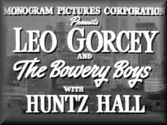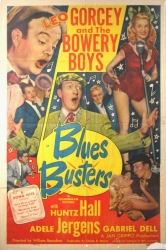FROM KIDS TO BOYS: THE PAST IMPREFECT OF THE BOWERY BOYS - Part Two
The Bowery Boys (1946-1958)
Included Leo Gorcey, Huntz Hall, Bobby
Jordan, Gabe
Dell, Billy Benedict, David Gorcey (aka David Condon), Bennie Bartlett,
Stanley Clements, Bernard Gorcey Unsatisfied
with his treatment at Monogram, Leo Gorcey effectively ended the East
Side Kids series by quitting in 1945. Along with Hall and
manager
Jan Grippo, Gorcey formed his own production company and revamped the
series as The Bowery Boys, with Gorcey, Hall and Grippo getting a
sizable cut of the profits. The films were once again made at and
released by Monogram.
Unsatisfied
with his treatment at Monogram, Leo Gorcey effectively ended the East
Side Kids series by quitting in 1945. Along with Hall and
manager
Jan Grippo, Gorcey formed his own production company and revamped the
series as The Bowery Boys, with Gorcey, Hall and Grippo getting a
sizable cut of the profits. The films were once again made at and
released by Monogram.
Sammy Morrison declined to join the new group, which soon consisted of the two Gorceys, Huntz Hall, Bobby Jordan and Gabriel Dell, who, as in the East Side Kids films, usually played an outsider with some familiarity with the gang. Leo's father Bernard Gorcey, who had appeared in the East Side Kids comedies, became Louie Dumbrowski, owner of Louie's Sweet Shop, which was the gang's main headquarters. Jordan and Dell soon left the series, as Leo Gorcey and Huntz Hall began to eat up much of the footage. Billy Benedict eventually exited too, leaving only Leo and David Gorcey (soon to be billed as David Condon), Huntz Hall and newcomer Bennie Bartlett.
Leo Gorcey was now Terence Aloysius Mahoney, more commonly known as "Slip". Hall was now Horace Debussy Jones, or "Sach" (rhymes with "catch", not "Bach"). Bobby Jordan played "Bobby", Billy Benedict "Whitey" and David Gorcey "Chuck". Gabe Dell was almost always Gabe Mareno, fairly-legitimate pal of the gang. When Bennie Bartlett arrived, he was christened "Butch", although the character would also be played by Buddy Gorman for a handful of films.
 The series
initially retained the street smart
sensibilities of the earlier days, with the boys, now men, playing
good-hearted hooligans who often found themselves trying to rectify
some neighborhood injustice, usually involving gangsters and other
shady characters. Many of the films were derivative,
borrowing
plots, situations, lines and gags from Abbott and Costello,
Martin
and Lewis, The Three Stooges, Laurel and Hardy and even The Marx
Brothers. If Abbott and Costello made a "hillbilly" picture
(1951's Comin' Round the Mountain),
it was a certainty The Bowery Boys would make their own soon after
(1952's Feudin' Fools).
Since Abbott and Costello and Martin and Lewis had great success with
their military comedies, the B-Boys eventually found
themselves in
every branch of the service: the Army (Bowery
Battalion - 1951), The Navy (Let's
Go Navy! - also 1951), the Marines (Here
Come the Marines - 1952) and the Air Force (Clipped Wings - 1953).
Inspired by the 1948 hit
Abbott and Costello Meet Frankenstein, they paid homage to
it twice with Master Minds
(1949 - a mad doctor wants Costello's brain...err... Sach's
brain for his monster, played by A&C
Meet Frankenstein's Glenn Strange) and The Bowery Boys Meet The (Rather
Generic) Monsters (1954).
The plot of Crazy Over Horses
bears a passing resemblance to the Marx Brothers 1937 hit A Day at the Races, and
1947's In Fast Company
reworks the Marx's classic stateroom scene from 1935's A Night at the Opera (the B-Boys
use a phone booth instead) and Groucho's "radio" commentary on a
climactic fight from 1931's Monkey
Business.
The series
initially retained the street smart
sensibilities of the earlier days, with the boys, now men, playing
good-hearted hooligans who often found themselves trying to rectify
some neighborhood injustice, usually involving gangsters and other
shady characters. Many of the films were derivative,
borrowing
plots, situations, lines and gags from Abbott and Costello,
Martin
and Lewis, The Three Stooges, Laurel and Hardy and even The Marx
Brothers. If Abbott and Costello made a "hillbilly" picture
(1951's Comin' Round the Mountain),
it was a certainty The Bowery Boys would make their own soon after
(1952's Feudin' Fools).
Since Abbott and Costello and Martin and Lewis had great success with
their military comedies, the B-Boys eventually found
themselves in
every branch of the service: the Army (Bowery
Battalion - 1951), The Navy (Let's
Go Navy! - also 1951), the Marines (Here
Come the Marines - 1952) and the Air Force (Clipped Wings - 1953).
Inspired by the 1948 hit
Abbott and Costello Meet Frankenstein, they paid homage to
it twice with Master Minds
(1949 - a mad doctor wants Costello's brain...err... Sach's
brain for his monster, played by A&C
Meet Frankenstein's Glenn Strange) and The Bowery Boys Meet The (Rather
Generic) Monsters (1954).
The plot of Crazy Over Horses
bears a passing resemblance to the Marx Brothers 1937 hit A Day at the Races, and
1947's In Fast Company
reworks the Marx's classic stateroom scene from 1935's A Night at the Opera (the B-Boys
use a phone booth instead) and Groucho's "radio" commentary on a
climactic fight from 1931's Monkey
Business.
All of this borrowing was appropriate as Leo Gorcey and Huntz Hall coalesced into a fine comedy team themselves during the series. This might be heresy to some, but Gorcey and Hall were probably closest inspirit to Laurel and Hardy rather than Abbott and Costello or Martin and Lewis, in that both members of the team got laughs - there was no straightman and comic. When one thinks of The Bowery Boys, they remember Slip mangling the English language ("Maybe I should insult my attorney!") and Sach ad-libbing through scenes and acquiring all sorts of bizarre, unearthly powers.
The Bowery Boys series eventually shifted to
almost pure comedy. Taking some things he learned
from Shemp Howard, who had appeared
in a handful of Little Tough Guy films, Huntz Hall transformed Sach
from a unintelligent but fairly normal guy into an innocent
and brainless man-child
like Lou Costello or Curly Howard. Gorcey and the directors knew they had a
surefire laugh-getter in Hall, and one often gets the feeling that
directors often said to the actor "Okay, you  walk into a scientist's
laboratory. Give me two minutes!" and then just let Hall
improvise his way around a set. Gag-filled films like Private Eyes (1953), Jungle Gents (1954) and Bowery to Bagdad
(1955) typify the all-out comedy approach the series took in
later
years. The series became so centered around Gorcey and Hall,
there often seems to be no reason for David Gorcey or Bennie Bartlett
to even be there except to stand behind the stars and pretend to look
interested.
walk into a scientist's
laboratory. Give me two minutes!" and then just let Hall
improvise his way around a set. Gag-filled films like Private Eyes (1953), Jungle Gents (1954) and Bowery to Bagdad
(1955) typify the all-out comedy approach the series took in
later
years. The series became so centered around Gorcey and Hall,
there often seems to be no reason for David Gorcey or Bennie Bartlett
to even be there except to stand behind the stars and pretend to look
interested.
In 1955, Bernard Gorcey was killed in a car accident, and a grieving Leo Gorcey began drinking more heavily than usual, disrupting the filming of Dig That Uranium. When Monogram refused to pay him more at the end of the film, he quit the series. Huntz Hall then received sole top billing ("Huntz Hall and The Bowery Boys") for the first time, and Stanley Clements, who had appeared in several of the East Side Kids comedies, came on board as "Stanislaus 'Duke' Coveleskie", but the series only lasted for seven more films, ending in 1958 with the 48th Bowery Boys film In The Money. - JB
NOTE: In all of these series, character names could change from film to film, but the names mentioned above represent the most common names used in the films, or as Slip Mahoney might say, "the most common demonikers."
From Kids to Boys: The Past Imprefect of the Bowery Boys - Part One


